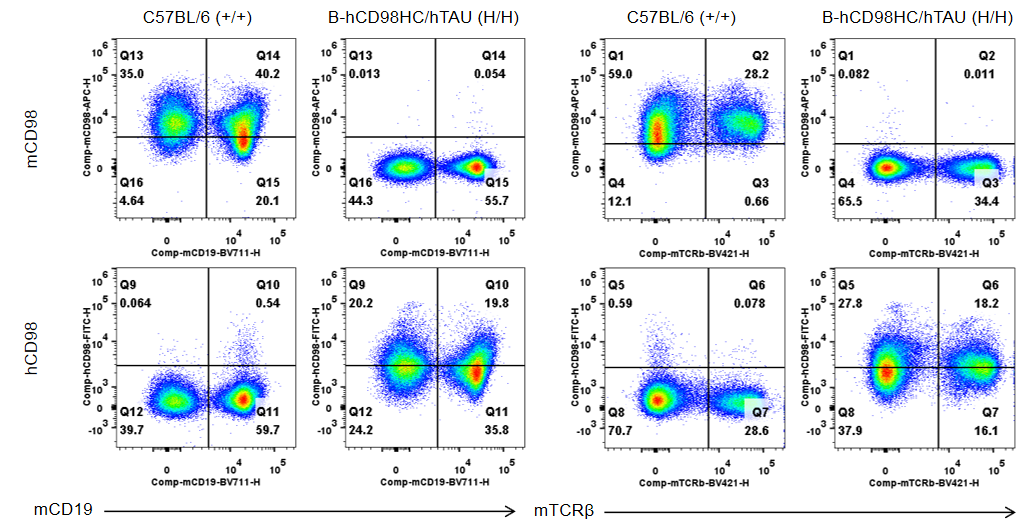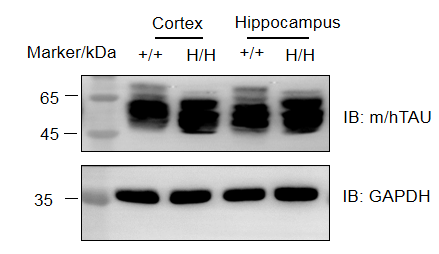B-hCD98HC/hTAU mice
| Strain Name |
C57BL/6-Slc3a2tm1(SLC3A2)Bcgen Mapttm1(MAPT)Bcgen/Bcgen |
Common Name | B-hCD98HC/hTAU mice |
| Background | C57BL/6 | Catalog number |
112829 |
|
Related Genes |
4F2, 4F2HC, 4T2HC, CD98, CD98HC, MDU1, NACAE; TAU, MSTD, PPND, DDPAC, MAPTL, MTBT1, MTBT2, tau-40, FTDP-17, PPP1R103, Tau-PHF6 |
||
|
NCBI Gene ID |
6520, 4137 | ||
- TAU is mainly distributed in the central nervous system, most of it exists in the axons of neurons, and a small amount exists in oligodendrocytes. TAU is involved in neurodegenerative diseases, and most prominently in the pathogenesis of Alzheimer disease (AD).
- CD98HC is a transmembrane glycoprotein that plays a key role in amino acid transport and cell adhesion. Certain therapeutic drugs exploit the transport mechanism mediated by CD98HC to effectively cross the blood-brain barrier. This ability is especially important for the treatment of neurological disorders.
- Gene editing strategy: The exons 2~10 of mouse Mapt gene that encode the full-length protein were replaced by human MAPT exons 2~15 in B-hCD98HC/hTAU mice. The 3’UTR region of the mouse gene are replaced by human counterparts. The chimeric MAPT expression is driven by endogenous mouse Mapt promoter, while mouse Mapt gene transcription and translation will be disrupted. The exons 2-10 of mouse Cd98 gene that encode the extracellular domain were replaced by human CD98 exons 4-12 in B-hCD98HC/hTAU mice.
- Protein expression analysis: TAU were detected in cortex and hippocampus of both wild-type C57BL/6 mice and homozygous B-hCD98HC/hTAU mice. Human CD98HC was exclusively detectable on T cells and B cells of homozygous B-hCD98HC/hTAU mice but not in wild-type C57BL/6 mice, and mouse CD98 was detectable only in wild-type C57BL/6 mice.
- Application: This product is used for pharmacodynamics evaluation of Alzheimer's disease (AD).
Targeting strategy
Gene targeting strategy for B-hCD98HC/hTAU mice. The exons 2~10 of mouse Mapt gene that encode the full-length protein were replaced by human MAPT exons 2~15 in B-hCD98HC/hTAU mice. The 3’UTR region of the mouse gene are replaced by human counterparts. The chimeric MAPT expression is driven by endogenous mouse Mapt promoter, while mouse Mapt gene transcription and translation will be disrupted. The exons 2-10 of mouse Cd98 gene that encode the extracellular domain were replaced by human CD98 exons 4-12 in B-hCD98HC/hTAU mice.

Strain specific CD98HC expression analysis in homozygous B-hCD98HC/hTAU mice by flow cytometry. Splenocytes were collected from wild-type C57BL/6 mice (+/+) and homozygous B-hCD98HC/hTAU mice (H/H), and analyzed by flow cytometry with anti-mouse CD98 antibody (Biolegend, 128211) and anti-human CD98HC antibody (Biolegend, 315603). Mouse CD98 was detectable in B cells and T cells form wild-type mice. Human CD98HC was exclusively detectable in B cells and T cells from homozygous B-hCD98HC/hTAU mice but not in wild-type mice.

Western blot analysis of TAU protein expression in homozygous B-hCD98HC/hTAU mice. Cortex and hippocampus lysates were collected from wild-type C57BL/6 mice (+/+) and homozygous B-hCD98HC/hTAU mice (H/H, 6-week-old mice), and then analyzed by western blot (anti-TAU antibody: CST, #46687). 40 μg total proteins were loaded for western blotting analysis. TAU were detected in cortex and hippocampus of both wild-type and homozygous mice.









